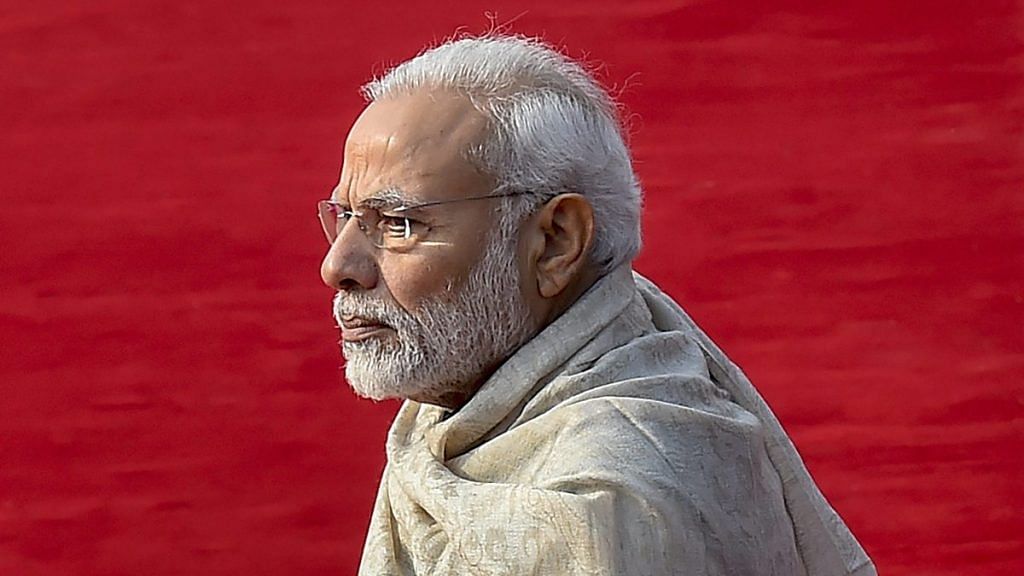The current NDA regime is no less hamstrung by an alternate power centre.
The Bharatiya Janata Party (BJP) has been gloating over The Accidental Prime Minister, a Vijay Ratnakar Gutte-directed film on former Prime Minister Manmohan Singh’s tenure. The ruling party, in a tweet, described the movie as a “riveting tale of how a family held the country to ransom for 10 long years.”
Many wouldn’t argue with the BJP on the verity of the dual power centres during the UPA regime, which left it riven and tottering.
Narendra Modi is not an accidental prime minister, his predecessor Singh was. But the current NDA regime is no less hamstrung by an alternate power centre—that is, the Rashtriya Swayamsevak Sangh (RSS), the BJP’s ideological fountainhead.
The RSS imprint on governance is, however, taken for granted and evokes little outrage because the prime minister and many of his Cabinet colleagues are self-certified former Sangh pracharaks and volunteers. The usual reaction, therefore, is: “Oh, tell me something new.”
Also read: Why The Accidental Prime Minister matters to ‘chowkidar’ Narendra Modi
But that doesn’t take away the fact that the power-without-responsibility phrase—which was once associated with the Nehru-Gandhi family—equally aptly describes the RSS’ position today. Take a look at the clout the Sangh wields in the current dispensation. Not to state the obvious, let’s exclude the point about the top decision-makers among the political executive being ex-RSS karyakartas.
Let’s also discount the fact that the RSS-associated think tank, Vivekanand International Foundation, provided critical resources to man powerful positions in the Modi government—national security adviser Ajit Doval, principal secretary to the prime minister, Nripendra Mishra, and Prasar Bharati chairman A Surya Prakash, to name a few.
The RSS’ inroads into the government run much deeper, in a rather insidious way. Consider the background of private secretaries, assistant private secretaries and other personal staff of union ministers. Most of them were once associated with the Akhil Bharatiya Vidyarthi Parishad (ABVP), the Sangh’s student wing, or were trained at Surya Foundation, a Haryana-based organisation associated with the Sangh, or at RSS leader Vinay Sahasrabuddhe’s Rambhau Mhalgi Prabodhini (RMP).
These gatekeepers posted in ministers’ offices serve as the eyes and ears of the RSS in the corridors of power.
A similar system of gatekeeping has been replicated in chief ministers’ offices in states where the BJP is in power. Himachal Pradesh chief minister Jairam Thakur, say BJP leaders from the state, was given a list with names of a political secretary, a media adviser and two officers on special duty (OSDs) by RSS leaders in Delhi for their posting in the CMO. He had no option but to comply. Rajat Sethi, a close aide of BJP general secretary and RSS leader Ram Madhav, was appointed political adviser to Jharkhand chief minister Raghubar Das.
Sethi had done his schooling from the RSS-run Shishu Mandir and gone on to study at IIT-Kharagpur and Harvard before joining Madhav’s team in Assam. Das had to comply with the Sangh’s wish to hire Sethi but wouldn’t entertain him much.
He would often get to know through newspaper reports about how Sethi was spearheading Jharkhand’s transformation.
Also read: What will Narendra Modi do if he is not PM in 2019?
Sethi soon shifted to Imphal as adviser to chief minister N Biren Singh. Another BJP chief minister told this writer that the pulls and pressures from various RSS leaders were so much that he wasn’t able to decide appointments in boards, corporations and authorities.
In Uttar Pradesh, ruled by Hindutva icon Yogi Adityanath, ministers, MLAs and anybody who matters are all seen scrambling every day to meet Sunil Bansal, state BJP general secretary (organisation) and Amit Shah confidant with RSS roots.
These are only a few instances that indicate the RSS’ grip on the levers of power at the Centre and in states. During the UPA regime, Sonia Gandhi was criticised for interfering in the government’s policies.
In the current NDA regime, the RSS and its affiliates seldom get the credit but everyone knows who forced the Modi government to put many things on the backburner—be it labour reforms, Air India disinvestment, FDI in multi-brand retail trade, or the national education policy.
Like the Congress’ top brass during the UPA regime, the RSS loves to wield power but won’t share responsibility for the lapses or reverses. US academic Walter Andersen, an authority on the RSS, was in India in August and met several Sangh leaders.
He said in an interview that the RSS says that the government has not done what it should have done in terms of job creation and instead become too allied with various ‘isms’ that are unsuitable to the present Indian situations.
Also read: Forget 2029, the Sangh Parivar is not even sure of 2019
The Sangh wouldn’t share the blame for the downslide in the BJP’s fortunes in the past year—not even for its loss in the tribal belts of Rajasthan, Madhya Pradesh and Chhattisgarh where Sangh affiliates have been working for five decades. And, the RSS would also not take the blame for replacing ‘vikas’—Modi’s USP—with ‘mandir’ as the BJP’s trump card should the saffron party suffer electoral reverses in 2019.
That’s exactly what the Congress did in 2013-14 when it saw the writing on the wall. Manmohan Singh became the fall guy as the Nehru-Gandhi family loyalists blamed his model of governance for the party’s failures.
But that’s how dual power centres work.
